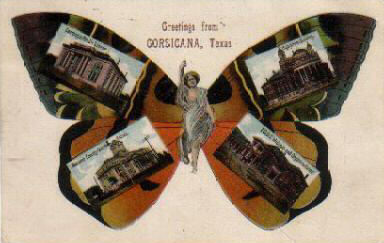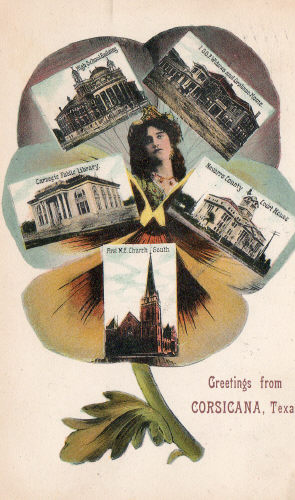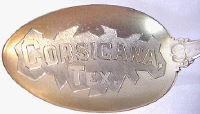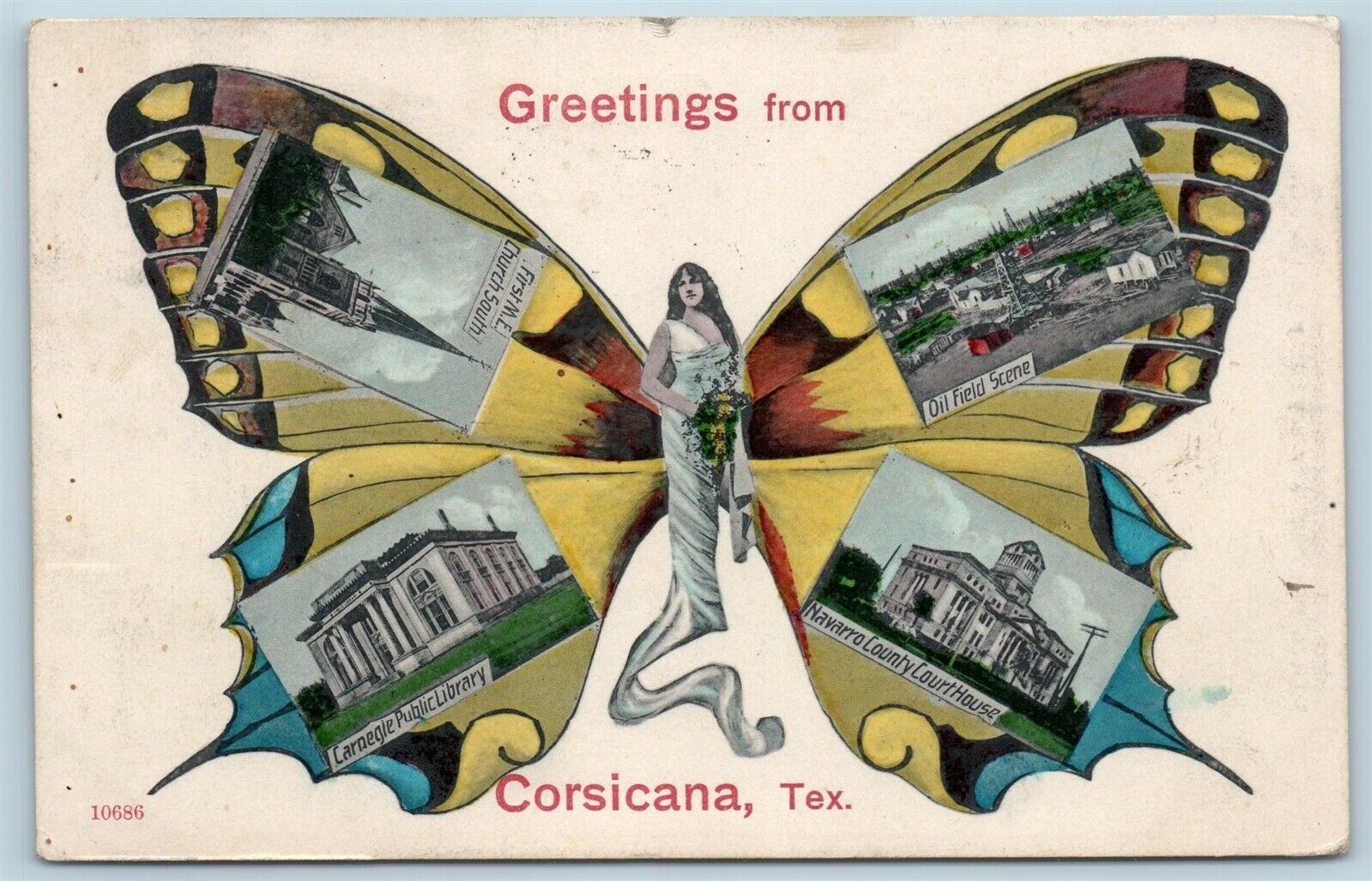|
CORSICANA, TEXAS. Corsicana, county seat and largest city of Navarro County, is in the central portion of the county fifty-eight miles southeast of Dallas at the junction of Interstate 45, U.S. highways 75 and 287, and State highways 22 and 31. It was established in 1848 to serve as the county seat of newly-established Navarro County. Josť Antonio Navarro,qv a hero of the Texas Revolutionqv after whom the county was named, was given the honor of naming the new town; he suggested Corsicana after the island of Corsica, the birthplace of his parents. David R. Mitchell, an early area settler, donated 100 acres for a townsite, and with the assistance of Thomas I. Smith, platted the land and began selling lots. The new town was centered near a log tavern built in 1847 and owned and operated by Rev. Hampton McKinney. The first courthouse, a two-room log structure, was constructed in 1849, and served as a church, meeting hall and civic center until a new frame building was constructed in 1853. The first school, taught by Mack Elliot and a man named Lafoon, opened in the old courthouse in 1847, and a short time later the Corsicana Female Literary Instituteqv began operating. Within a few years of the town's founding, a large number of mercantile establishments opened on and around the courthouse square, and new brick courthouse-a symbol of the town's growing prosperity-was erected in 1858. The first newspaper, the Prairie Blade, was founded in 1855; it was replaced by the Express in 1857, which in turn was replaced by the Observer on the eve of the Civil War.qv
The greatest spur to the town's development, however, came in November 1871 with the completion of the Houston and Texas Central Railroad. The coming of the railroad brought numerous settlers and new merchants, among them the Sanger Brothers,qv the Padgitts and others, who established stores near the new depot on East Collin Street. The construction of the Texas and St. Louis Railway (later the Cotton Belt) in 1880 prompted further commercial development, and by the mid-eighties Corsicana had become the leading trading and shipping center for a large area of the northern blacklands. In 1872 the town was incorporated with a mayoral form of government, and in 1880 a public school system was organized. The decade of the eighties also saw the establishment of a city fire department, a municipal water works, the installation of the first telephone system, and the construction of the State Orphans Home and the Odd Fellows Orphans Home. By 1885 Corsicana had a population of approximately 5,000, three Presbyterian, a Catholic, a Baptist, and three Methodist churches, as well as three blacks churches, an oil factory, a gristmill, two banks, and four weekly newspapers-the Courier, the Observer, the Messenger, and the Journal; principal products included cotton, grain, wool, and hides. By the early 1890s the rapidly expanding city had outgrown its water
supply, and the following year civic leaders formed the The oil boom brought a new wave of prosperity to the town. A new courthouse-the one still in use in 1990-was completed in 1905, and in 1917 the Corsicana Chamber of Commerce was founded. The decades after 1900 also saw significant improvements in transportation. The Corsicana Transit Company converted from mule-drawn cars to electric trolleys in 1902; in 1912 the Trinity and Brazos completed a line between Corsicana and Houston; and in 1913 the Texas Electric Railroad instituted hourly service to and from Dallas. In 1923 a second, even larger oil deposit, the Powell oilfield, was discovered, unleashing a new oil boom. Within a few months Corsicana's population swelled to unprecedented heights; some estimates placed the number of residents as high as 28,000 during the peak months of the oil frenzy. New construction transformed the face of the city, and street lights were installed for the first time to control the increased traffic. During the height of the Powell field boom 550 wells in and around the city produced an estimated 354,000 barrels per day. As the boom subsided, the population dropped-to 11,300 in 1925-but it rebounded at the end of the decade, reaching 15,202 in 1930. With the onset of the Great Depression in the early 1930s many Corsicanans found themselves out of work. The number of rated businesses declined from a high of 780 in 1931 to 500 in 1936. Particularly hard hit was the cotton wholesale and processing industry, which suffered from the combined effects of falling prices and the boll weevil.qv The oil industry helped to mitigate the worst effects of the depression, however, and by the end of the decade the Corsicana economy was already beginning to show signs of a rebound. On the eve of World War IIqv Corsicana had five banks, a daily newspaper (the Daily Sun), three movie theaters, three hospitals, three hotels, a cotton mill, a refinery, and two oil pumping stations. The reported population in 1940 was 17,500, of whom 77% were white and 23% black. Corsicana grew again during the war. In 1942 Air Activities of Texas opened a large flight training center where thousands of pilots received basic training, and in 1942 Bethlehem Steel took over the American Well Prospecting Plant, expanding the production of rotary drills.
Since that time Corsicana has experienced steady, if not spectacular, growth. The population reached 20,750 in 1965 and 25,189 in 1991. The number of businesses saw a sharp drop, from 550 in 1965 to 394 in the mid-1970s, but the number rebounded, and in 1991 the town reported 485 businesses. The leading industries in 1991 included oil and gas extraction, meat packing, fruit and vegetable canning, the printing of business forms, and manufacture of prepared foods, furniture, chemical and rubber products, and oil field machinery. BIBLIOGRAPHY: Corsicana Chamber of Commerce, Facts about Corsicana, Texas (Corsicana: Stokes Printing, 1935). C. L. Jester, Short History of Navarro County and Corsicana (Austin: University of Texas Library, 1943). Annie Carpenter Love, History of Navarro County (Dallas: Southwestern, 1933). Marker Files, Texas Historical Commission, Austin. Carl Mirus, "A Short History of the Corsicana Shallow Oil Field," Navarro County Scroll, 1956. William Polk Murchison, Corsicana in Civil War and Reconstruction Days (University of Texas Bulletin 2546, December 8, 1925). William Polk Murchison, The Early History of Corsicana (University of Texas Bulletin 2746, December 8, 1927). Wyvonne Putman, comp., Navarro County History (5 vols., Quanah, Texas: Nortex, 1975-84). Alva Taylor, History and Photographs of Corsicana and Navarro County (Corsicana, Texas, 1959; rev. ed., Navarro County History and Photographs, Corsicana, 1962). Vertical Files, Barker Texas History Center, University of Texas at Austin. Christopher Long "CORSICANA, TX." The Handbook of Texas Online.
Statistics & Facts:
Indexes:
Corsicana Cemeteries |


 By 1850 Corsicana's population had already grown to some 1,200, 300 of
whom were reportedly black slaves. Not surprisingly given the town's large
number of slaveholders, Corsicanans supported Breckinridge over the Fusionist
slate of candidates in the presidential election of 1860; and in February 1861,
when had the election was held on the secession issue, the vote was almost
unanimous, 213 in favor and only three opposed. At outbreak of the war in April
1861 townspeople held a mass demonstration on the courthouse square in favor of
the Confederacy, and appeals were made for volunteers to serve in the
Confederate Army in Virginia. The first company, the "
By 1850 Corsicana's population had already grown to some 1,200, 300 of
whom were reportedly black slaves. Not surprisingly given the town's large
number of slaveholders, Corsicanans supported Breckinridge over the Fusionist
slate of candidates in the presidential election of 1860; and in February 1861,
when had the election was held on the secession issue, the vote was almost
unanimous, 213 in favor and only three opposed. At outbreak of the war in April
1861 townspeople held a mass demonstration on the courthouse square in favor of
the Confederacy, and appeals were made for volunteers to serve in the
Confederate Army in Virginia. The first company, the " Corsicana Water
Development Company with the aim of tapping a shallow artesian well in the area.
Drilling began in the spring of 1894; but instead of water, the company hit a
large pocket of oil and gas. The find-the first significant discovery of oil
west of the Mississippi River-led to Texas's first oil boom: within a short time
nearly every lot in the town and in the surrounding area was under lease, and
wells were being drilled within the city limits: five in 1896, and fifty-seven
the following year. The first oil refinery in the state was built in 1897, and
by 1898 there were 287 producing wells in the Corsicana field.qv
The oil find attracted numerous oil men from the East, among them Edwy R. Brown,qv
H. C. Folger, W. C. Proctor, C. N. Payne, and
Corsicana Water
Development Company with the aim of tapping a shallow artesian well in the area.
Drilling began in the spring of 1894; but instead of water, the company hit a
large pocket of oil and gas. The find-the first significant discovery of oil
west of the Mississippi River-led to Texas's first oil boom: within a short time
nearly every lot in the town and in the surrounding area was under lease, and
wells were being drilled within the city limits: five in 1896, and fifty-seven
the following year. The first oil refinery in the state was built in 1897, and
by 1898 there were 287 producing wells in the Corsicana field.qv
The oil find attracted numerous oil men from the East, among them Edwy R. Brown,qv
H. C. Folger, W. C. Proctor, C. N. Payne, and
 Corsicana's leading industries during the 1950s included the Texas-Miller
Products Company, a leading producer of hats; the
Corsicana's leading industries during the 1950s included the Texas-Miller
Products Company, a leading producer of hats; the 